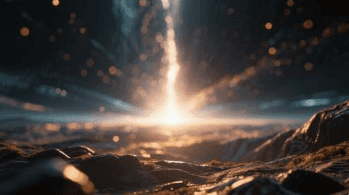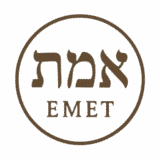Christ Revealed in Genesis : Hidden Gospel & Divine Presence
When we open the Bible, the very first verse we encounter is Genesis 1:1: “In the beginning God created the heavens and the earth.” It may appear to be a simple declaration about the origin of the world. Yet when we read it in Hebrew and trace its letters, symbols, and hidden meanings, we find the presence of Christ shining through. This verse does not only tell us that God created, but also how He revealed Himself, His covenant, and His Son in creation. The hidden gospel is there before the second verse even begins.
The Word in the Beginning
The Hebrew word Bereshit (בְּרֵאשִׁית), “In the beginning,” contains a profound mystery. Each letter speaks with prophetic depth. The Bet (ב) shows us a house, a dwelling. Creation began with God preparing a dwelling place for His people. The Resh (ר) is the head, the beginning, reminding us that God is first over all things. The Aleph (א) represents God Himself, strong and sovereign. The Shin (ש) pictures fire or teeth, pointing to both judgment and the consuming presence of the Spirit. The Yod (י) is the hand, the work of God shaping creation. Finally, the Tav (ת) is the covenant sign, a mark shaped like a cross in its ancient form.
When taken together, this first word gives us more than a time marker. It says, “From the house, the head, God through His consuming fire, His hand, and His covenant, all creation began.” Christ is already present here, hidden in the Tav, the cross-shaped sign of covenant. The New Testament confirms this when John begins his gospel with the same phrase, “In the beginning was the Word, and the Word was with God, and the Word was God.” Genesis 1:1 and John 1:1 are joined, for the Word who was there at creation is Christ Himself.
The next word, bara (בָּרָא), “created,” is used only for God’s creative acts. Humanity can shape and build, but only God brings something out of nothing. The letters again remind us who is at work. The Bet shows us a house, the Resh the head, and the Aleph the strong One, God Himself. Together it means, “The Head of the House is God.” Creation is not random but an ordered act of the divine Head. Christ, as Colossians 1:16 tells us, is the One through whom all things were created. The Word spoken in Genesis is the Son Himself, building the house of creation.

The third word, Elohim (אֱלֹהִים), names God but with layers of meaning. The Aleph shows God’s strength. The Lamed is the shepherd’s staff, authority and guidance. The Hey means “behold,” revelation. The Yod is again the hand, work in action. The Mem pictures water, chaos, or nations. Together it says, “The Strong One with authority is revealed through His hand over the waters.” Creation began with chaos, but God brought order by His Word. In Christ we see the same truth: He is the shepherd, the revelation of God, the hand stretched out to calm the waters, and the One who has authority over all nations.
Christ as the Aleph and the Tav
The next word, et (אֵת), appears in Hebrew but has no direct translation in English. It is made of Aleph (א) and Tav (ת), the first and last letters of the Hebrew alphabet. Its presence here is not accidental. It marks the objects of creation, but it also whispers of the Messiah. Jesus declares in Revelation 22:13, “I am the Alpha and the Omega, the First and the Last, the Beginning and the End.” In Hebrew terms, He is the Aleph and the Tav. That untranslatable word in Genesis 1:1 is a prophetic marker of Christ Himself, the One present from the first moment, the beginning and the end embodied in creation.
When we come to hashamayim (הַשָּׁמַיִם), “the heavens,” the letters again reveal a story. The Shin is fire, the Mem is water, the Yod is God’s hand, and the final Mem points to water or eternity. The heavens, then, are the place where fire and water, judgment and mercy, are held in balance by God’s hand. Christ is the One who upholds all things, holding the spiritual realms in harmony. The heavens are not chaotic but ordered by the Word who sustains them.
The phrase continues with ve’et (וְאֵת), “and Aleph-Tav.” The Vav is a nail or hook, a connector. Here is where the gospel shines brightest. The nail connects the beginning and the end. It is a picture of the cross, the divine nail that joins heaven and earth, God and humanity. The cross is hidden in the very structure of the verse. Before sin, before sacrifice was needed, the covenant of redemption is already pictured. The Vav, the nail, shows Christ crucified as the one who holds creation together.
Finally, we reach ha’aretz (הָאָרֶץ), “the earth.” Its letters show us Aleph for God, Resh for head, and Tsade for the righteous one. The message is clear: the earth is the place where God, the head, establishes righteousness. Humanity was created to reflect God’s righteousness on earth. Yet the earth also becomes the stage where Christ, the Righteous One, humbles Himself. The Tsade can picture a fishhook, reminding us of humility and being drawn low. Christ descended to the earth, bore humility, and through His righteousness lifted the world back to God.
The Gospel Encoded in Creation
When all the words are read together, the message is astounding. Genesis 1:1 does not simply say, “God created the heavens and the earth.” It tells us, “In the beginning, from the house and the head, God created by His authority and revelation, through the Aleph and Tav, the heavens as His ordered spiritual realm and the earth as the place of righteousness. The nail of the cross connects heaven and earth.” The verse holds within it the entire gospel story: creation, covenant, cross, and Christ.
This hidden gospel reminds us that Christ was not an afterthought, nor did He appear only in Bethlehem. He is present in the very first word of Scripture. The Tav shows His cross, the Aleph-Tav names Him as the beginning and the end, and the Vav reveals the nail that would pierce His hands. The structure of creation itself is covenantal, rooted in Christ’s sacrifice and sustained by His power.
The New Testament writers recognized this truth. John begins with the same phrase, “In the beginning,” to show Christ as the eternal Word. Paul declares in Colossians 1:17 that “He is before all things, and in Him all things hold together.” Hebrews 1:2 says God made the world through His Son. Revelation names Him the Alpha and Omega, which in Hebrew is the Aleph and the Tav. The hidden signs in Genesis 1:1 are fulfilled openly in Christ.
When God created the heavens and the earth, He was already revealing the plan of redemption. The cross was not a reaction to sin but part of the covenantal design from the start. Creation points to Christ, redemption flows through Christ, and the new creation will be completed in Christ. Heaven and earth, mentioned side by side in Genesis 1:1, find their unity in Him. As Ephesians 1:10 says, God’s plan is “to bring unity to all things in heaven and on earth under Christ.” The first verse of Scripture already sets this theme.
Christ, the Beginning and the End
So, Genesis 1:1 is far more than a statement of origin. It is a revelation of Christ. From the first letter Bet to the final Tsade, the message of the gospel is woven in. The house of creation is built by God’s hand. The head of the house is God Himself. The Aleph and Tav mark Christ as the center and the boundary of creation. The Vav, the nail, reveals the cross. The heavens are ordered by fire and water in His hand. The earth is meant to display righteousness. All of it is pointing to Him.

When we read Genesis 1:1 with eyes open to Christ, we see not just creation but covenant, not just power but promise. Christ is the hidden Word in the beginning, the revealed Word in the flesh, and the eternal Word who will bring heaven and earth together. Even before the story of humanity begins, the story of redemption is already written in the letters. The cross shines through the Tav, the Aleph-Tav declares His eternity, and the Vav connects us forever to God.
In this way, Genesis 1:1 is not only the first verse of the Bible but the first whisper of the gospel. The Creator is the Redeemer. The One who spoke the heavens and the earth into existence is the same One who will renew them. Christ is in the beginning, Christ is in the middle, and Christ is the end. The story of creation is His story, and in Him, all things hold together.
